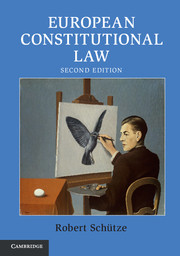Book contents
- Frontmatter
- Dedication
- Summary Contents
- Contents
- List of Illustrations
- List of Tables
- List of Cases
- List of Secondary Law
- Table of Equivalents
- List of Abbreviations
- Acknowledgements
- Introduction: European Constitutional Law
- Part I Constitutional Foundations
- Part II Governmental Powers
- 7 Legislative Powers: Competences and Procedures
- 8 External Powers: Competences and Procedures
- 9 Executive Powers: Competences and Procedures
- 10 Judicial Powers I: (Centralised) European Procedures
- 11 Judicial Powers II: (Decentralised) National Procedures
- 12 Judicial Powers III: EU Fundamental Rights
- Appendices
- Index
- References
10 - Judicial Powers I: (Centralised) European Procedures
from Part II - Governmental Powers
- Frontmatter
- Dedication
- Summary Contents
- Contents
- List of Illustrations
- List of Tables
- List of Cases
- List of Secondary Law
- Table of Equivalents
- List of Abbreviations
- Acknowledgements
- Introduction: European Constitutional Law
- Part I Constitutional Foundations
- Part II Governmental Powers
- 7 Legislative Powers: Competences and Procedures
- 8 External Powers: Competences and Procedures
- 9 Executive Powers: Competences and Procedures
- 10 Judicial Powers I: (Centralised) European Procedures
- 11 Judicial Powers II: (Decentralised) National Procedures
- 12 Judicial Powers III: EU Fundamental Rights
- Appendices
- Index
- References
Summary
Introduction
When compared to the legislative and executive branches, the judiciary looks like a poor relation. For the classic civil law tradition reduces courts to ‘the mouth that pronounces the words of the law, mere passive beings that can moderate neither its force nor its rigour’. And even the common law tradition finds that ‘[w]hoever attentively considers the different departments of power must perceive, that in a government in which they are separated from each other, the judiciary, from the nature of its functions, will always be the least dangerous to the political rights of the constitution; because it will be least in a capacity to annoy or injure them’. In the eyes of both traditions, the judiciary is thus ‘the least dangerous branch’. This traditional view originated in the eighteenth century and reduced the judiciary to its adjudicatory function. The sole function of courts is here to decide disputes between private or public parties.
Yet this view was to change dramatically in the nineteenth and twentieth centuries. Courts not only succeeded in imposing their control over the executive branch. Some States would even allow for the constitutional review of legislation. In Marbury v. Madison, the American Supreme Court thus claimed the power to ‘un-make’ a law adopted by the legislature. It justified its annulment power as follows: ‘all those who have framed written constitutions contemplate them as forming the fundamental and paramount law of the nation, and consequently the theory of every such government must be that an act of the legislature, repugnant of the constitution is void’.
These judicial ‘victories’ over the executive and legislative branch were inspired by the idea that a State should be governed by the ‘rule of law’, that is: a legal order should provide for judicial mechanisms to review the ‘legality’ of all governmental acts. And this idea would, in some legal orders, include the sanctioning power of the judiciary to order a State to make good damage caused by a public ‘wrong’.
A modern definition of the judicial function will therefore need to include three core powers, which – in descending order – are: the power to annul legislative or executive acts, the power to remedy public wrongs through governmental liability, and the power to adjudicate legal disputes between parties.
- Type
- Chapter
- Information
- European Constitutional Law , pp. 343 - 393Publisher: Cambridge University PressPrint publication year: 2015
References
- 1
- Cited by



